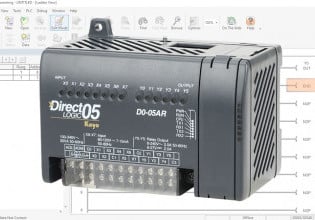An Introduction to Ball Valves in Control Systems
In control systems using fluid or airflow, ball valves can restrict pressure leaks and connect instruments in a network.
Ball valves are control valves that regulate fluid flow. They are used in applications where the full-on or full-off condition of a fluid flow is required. For example, ball valves are installed at the compressed air source in a compressed air supply to a machine.
The main difference between a ball valve and other valves is that the ball valve has a ball inside a valve body to control the fluid flow. The ball has a bore in it and is attached to the handle. When the handle is rotated, the ball also rotates. When the bore aligns with the fluid flow, it allows the fluid to flow. It stops the flow when the bore is not aligned.
Types of Ball Valves
Ball valves can be categorized according to many criteria, such as size, applications, and industry. Following are common ball valves according to their industrial applications.
Standard Port Ball Valve
Standard port ball valves are often used in industry. However, they pose a slight restriction in fluid flow from the valve inlet to the outlet. The ball size inside the valve is the same as the inlet and outlet, making the bore size small compared to the valve.
These valves are not heavy, oversized, or generally expensive. The standard ball valves are used in pressure or flow drop applications.
Full Port Ball Valve
Full port ball valves offer no or minimized resistance to the fluid flow from the inlet to the outlet of the ball valve, and there is no flow drop. Since the bore size matches the inlet and outlet, the ball size inside the valve is slightly oversized to accommodate the bore size.
These valves are bulkier and expensive compared to the standard due to the oversized ball. These valves are used where pressure or flow drop across the attached network is unacceptable, such as in pigging applications for piping.
V Ball Valve
The main characteristic of the v ball valve is the v-shaped contour in the ball instead of the standard bore in the ball. The angled contour provides more control over fluid flow with an increased response time that may not be possible with other control valves.

Figure 1. A V ball valve. Image used courtesy of Dwyer
For this reason, a small-sized v valve can achieve higher fluid flow characteristics than other larger-sized control valves. V ball valves can also be used at high fluid flow pressure applications.
Multi-port Ball Valve
Multi-port ball valves provide the option of selecting two ports among the available ones. The connection is made through a common internal ball structure flexible in selecting, depending upon the application requirement. There are two arrangements available: T- and L-shaped.

Figure 2. A schematic of T-shaped and L-shaped ball valves. Image used courtesy of Ruben Castelnuovo
In T-shaped structure, engineers can connect between any available ports without any restriction. In L-shaped structure, engineers can connect between the central port and any side port. Technicians cannot make the connection between any of the side ports.
Reduced Port Ball Valve
The reduced port ball valve has a small-sized bore compared to the valve inlet and outlet. This reduced size reduces the fluid flow across the valve. They are used in applications that require low pressure across the attached network or where pressure drop across the network is acceptable.
Comparing Ball Valves to Other Flow Valves
Ball valves offer distinct characteristics having unique advantages over another flow valve. Following are some applications that make the ball valve unique.
Strict Control of Pressure Leak
Ball valves are used in gas and liquid applications requiring strict leak control practices. The fluids may be expensive or deadly to humans, such as toxic chemicals. This is often the case in industries where the fluid leak is unacceptable, such as in laboratories.

Figure 3. An application of ball valves. Image used courtesy of Dwyer
Ball valves provide accurate sealing of valves both at the inlet and outlet. The valve structure and material also make it challenging to leak through the valve body.
Instrument Connection
Ball valves can connect instruments such as air pressure sensors or pressure gauges with the network to measure and monitor fluid characteristics where required.

Figure 4. An application where a ball valve connects system components. Image used courtesy of Dwyer
The selection of the ball valve depends on the instrument and fluid characteristics. To connect the instrument, the ball valve attaches to the fluid network. The instrument is then connected to the ball valve. In the event of fault or maintenance, the ball valve disconnects the device from the attached network. This enables the maintenance personnel to carry out the maintenance activity without disturbing the fluid flow in the connected network.
Steam Applications
Ball valves are also preferable in steam applications. The ball valve can be turned on or off with little or no resistance, allowing them to operate efficiently. Another advantage is that ball valves prevent steam leakage due to their strict pressure characteristics. The ball valve can also bear the high temperature and pressure of steam.
Advantages and Disadvantages of Ball Valves
This section lists some advantages and disadvantages of ball valves over other valve types.
Advantages
They provide leak-free fluid flow in the attached network without additional seals or lubrication. They are suitable for industries where precious fluid leaks can be costly and dangerous for humans and the environment, such as pharmaceutical or chemical.
Their size is small compared to other control valves, making them easy to operate, with less force and time. This property enables the operator to operate the ball valve without help from other personnel, which becomes crucial in emergency cases requiring quick valve operation.
Ball valves can connect instruments in the attached fluid network. They provide a safe connection port for the devices. The ball valve disconnects the fluid network with the instrument port and makes it easy for the operators to install, repair, or replace the instrument.
Disadvantages
Ball valves are not suitable for operations requiring reduced pressure operations. Their internal design and construction do not make them ideal for partial on or off operations. They are not recommended for systems where the pressure at the source is at a higher value, and the target systems require reduced pressure.
Their internal design makes them difficult to use with thick fluids. Thick fluid concentrations can be deposited in the inner body and become trapped inside. These trapped concentrations are difficult to remove and can deteriorate the ball valve material and construction.
Even though there are a few disadvantages, ball valves have far more advantages in industrial applications. Each ball valve type has optimal uses, such as full port ball valves for pigging in oil pipelines. Where do you use ball valves in your facility?






